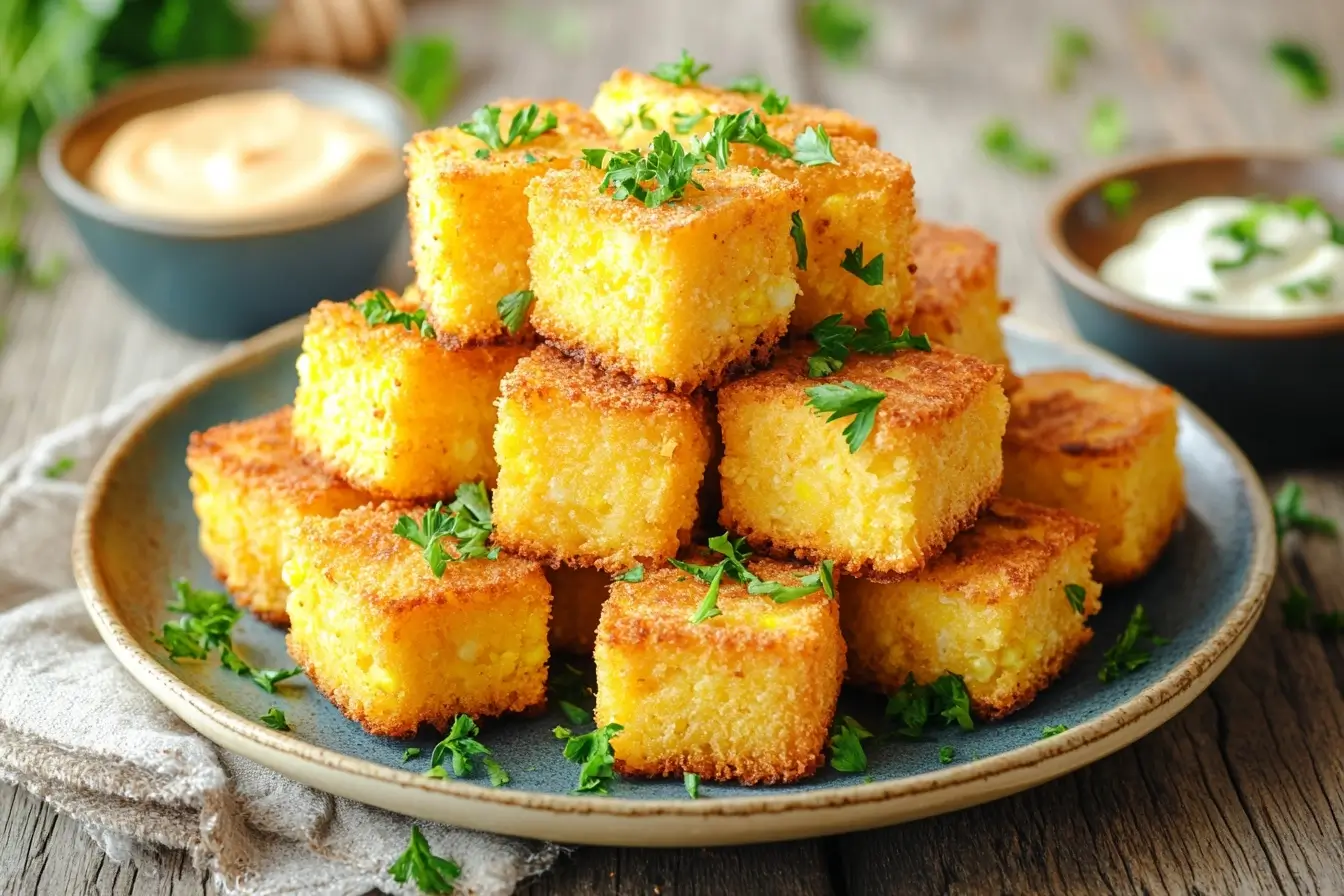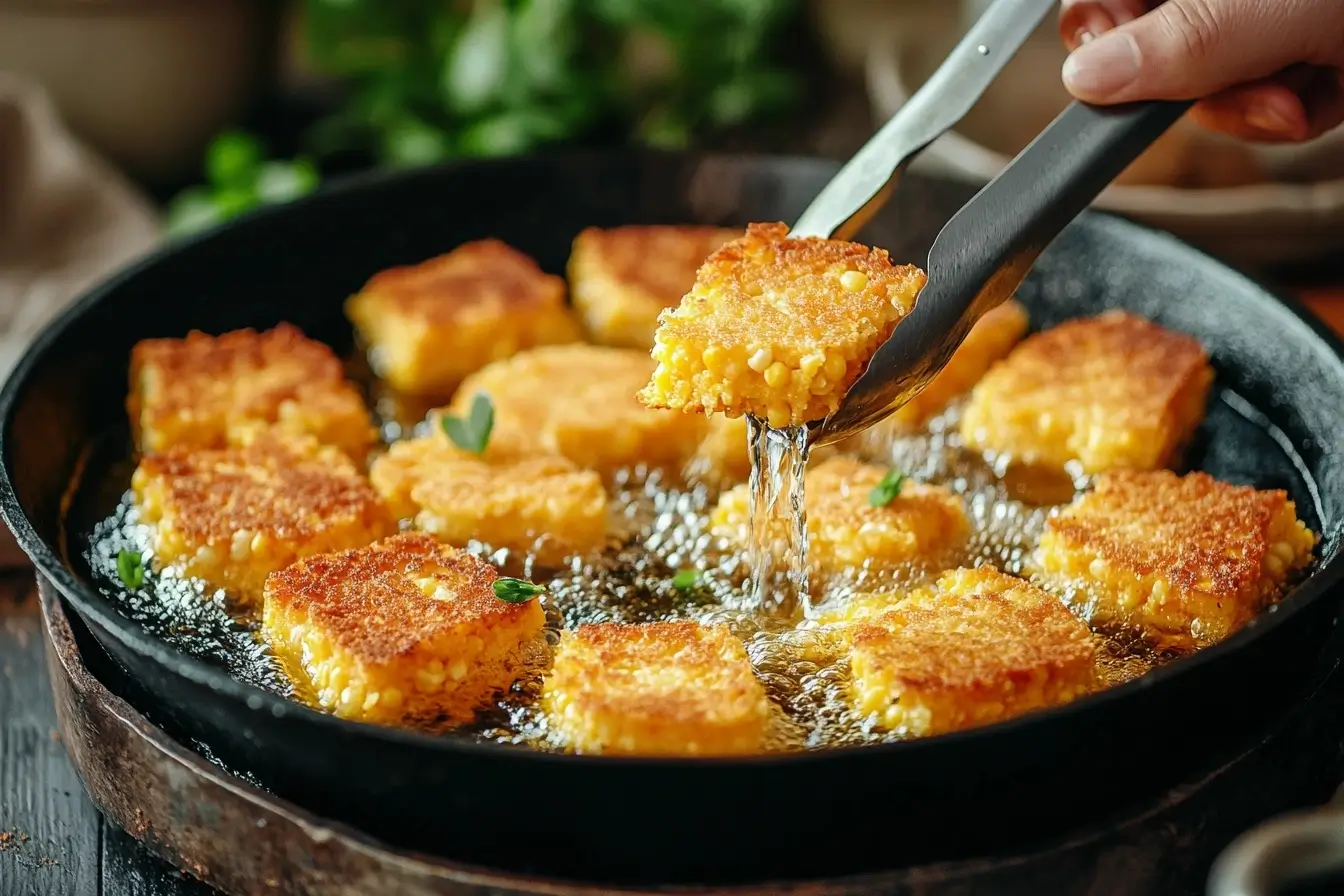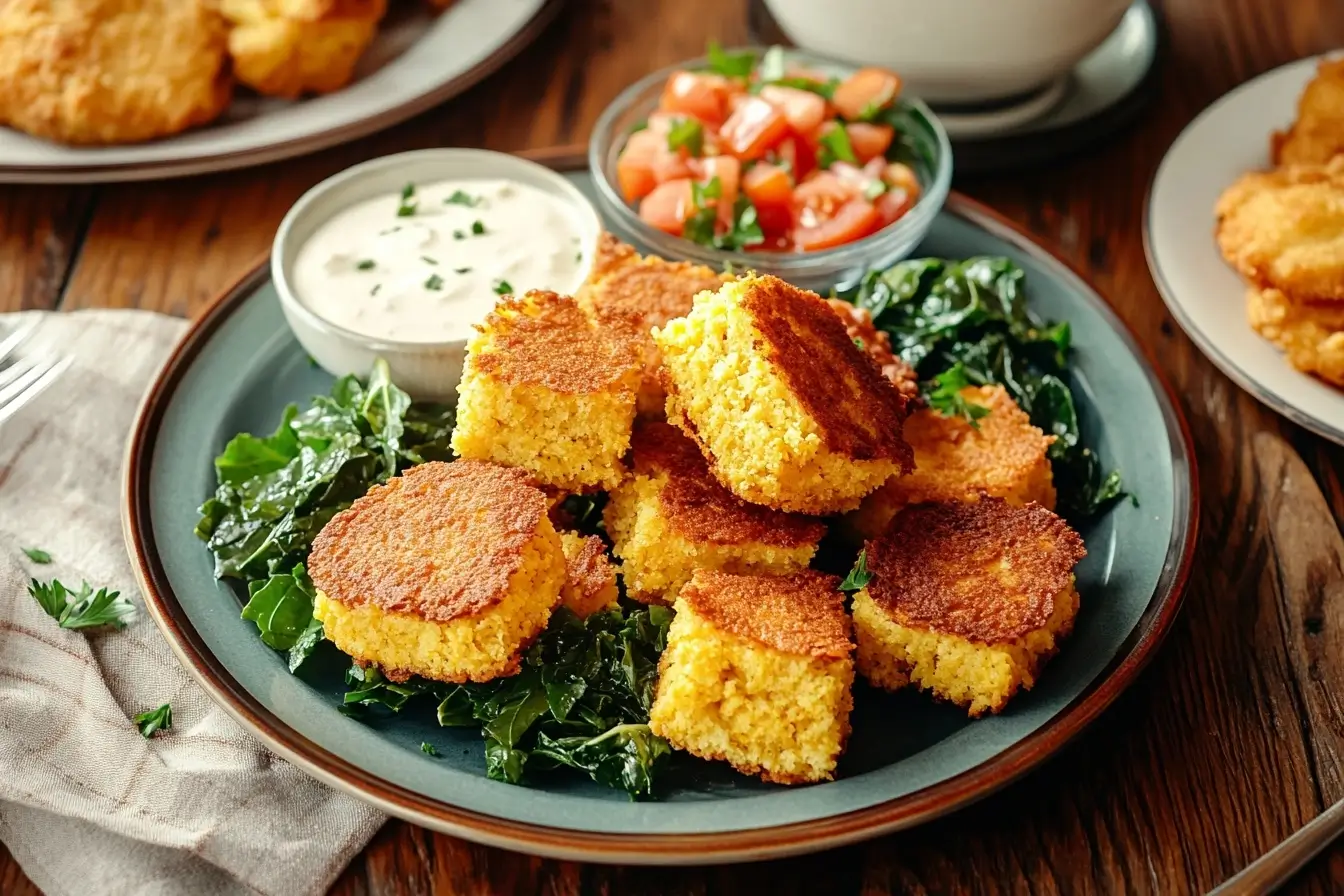Cornbread fritters are the epitome of comfort food—crispy on the outside, fluffy on the inside, and bursting with flavor. Whether served as a snack, a side dish, or even the main star of the meal, these little bites bring Southern charm to the table. This guide dives deep into everything you need to know about cornbread fritters—their origins, ingredients, cooking tips, and how to troubleshoot common issues. By the end, you’ll have the skills to whip up fritters that’ll make everyone ask for seconds.
Now, let’s roll up our sleeves and explore this golden, delicious world.
What Are Cornbread Fritters?
A Brief Introduction to Cornbread Fritters
Cornbread fritters are a delectable twist on traditional cornbread, blending the beloved flavors of the South with a crispy, fried exterior. Think of them as bite-sized, pan-fried versions of cornbread. The origins of these fritters can be traced back to Southern kitchens, where resourceful cooks found creative ways to make use of simple, affordable ingredients.
Unlike standard cornbread, which is baked, cornbread fritters are fried in oil or butter, giving them a rich, crunchy texture. Their versatility is unmatched—you can go savory with jalapeños and cheese or sweet with honey and powdered sugar. These fritters are not only a treat for the taste buds but also a nostalgic nod to home-cooked meals shared with loved ones.
Popular Variations Around the World
While cornbread fritters are quintessentially Southern, they’ve inspired variations far and wide. In the U.S., the South celebrates its savory fritters alongside dishes like collard greens and fried chicken. Meanwhile, sweet versions often appear on brunch menus, drizzled with syrup.
Globally, these fritters take on exciting twists. Caribbean-inspired versions might include coconut and spices, while fusion recipes add ingredients like scallions or curry. No matter the adaptation, the heart of the dish remains the same: cornmeal and love, fried to perfection.
The Key Ingredients for Perfect Cornbread Fritters
Traditional Ingredients
Making cornbread fritters starts with a solid foundation of traditional ingredients. Cornmeal is the star of the show, lending that earthy, slightly sweet flavor and a bit of grit for texture. Choose finely ground or medium cornmeal for a balanced crunch. Adding flour helps bind the fritters, creating a structure that’s firm yet tender.
The wet ingredients bring it all together. Buttermilk adds tanginess and moisture, while eggs provide richness and act as a natural glue for the batter. A dash of baking powder ensures those fritters puff up nicely in the pan. Don’t forget a pinch of salt—it enhances every flavor in the mix.
For an extra layer of comfort, a touch of butter or oil mixed into the batter delivers a melt-in-your-mouth finish.
Creative Additions to Elevate Flavor
Why stop at the basics? The beauty of cornbread fritters lies in their adaptability. To create savory fritters, toss in shredded cheese, diced jalapeños, or chopped scallions for a zesty twist. Want something sweet? Stir in a drizzle of honey or a sprinkle of cinnamon for a delightful breakfast or dessert option.
For inspiration, consider this Honey Butter Skillet Corn recipe. You can incorporate similar flavors into your fritters for a sweet-savory fusion that’ll leave taste buds tingling.
Step-by-Step Guide to Making Cornbread Fritters
Prepping Your Ingredients
Start by measuring and prepping all your ingredients. Ensure your cornmeal is fresh; stale cornmeal can dull the flavor. Sift the dry ingredients together—cornmeal, flour, baking powder, and salt—to ensure a light and even batter.
In a separate bowl, whisk the wet ingredients: buttermilk, eggs, and melted butter. Gradually add the dry ingredients to the wet, stirring gently to avoid overmixing. Overworked batter can make your fritters tough.
Cooking Techniques
The secret to perfectly fried cornbread fritters lies in the heat. Heat your oil to medium-high; it should shimmer but not smoke. Drop small scoops of batter into the pan, leaving room for them to expand.
Fry each fritter for about 2-3 minutes per side or until golden brown. Use a slotted spoon or tongs to transfer them to a paper towel-lined plate to drain any excess oil.
For a healthier alternative, consider baking your fritters in a preheated oven at 375°F. Use a greased muffin tin to keep their shape intact.
Common Mistakes to Avoid
If your fritters are dense, check your baking powder—it might be past its prime. Also, don’t skip the resting step; letting the batter sit for 5-10 minutes before frying allows the dry ingredients to hydrate fully, ensuring a tender texture.
If you’re looking for additional ideas, check out these Corn Nuggets for creative twists on fritters with a creamy filling.
Serving and Pairing Suggestions for Cornbread Fritters
Best Pairings for a Complete Meal
Cornbread fritters are more than just a snack—they can steal the spotlight as part of a hearty meal. For a classic Southern experience, serve fritters alongside collard greens, fried chicken, or a steaming bowl of chili. Their crispy, golden exterior provides the perfect contrast to creamy or saucy dishes.
If you prefer lighter pairings, consider a fresh salad with a tangy vinaigrette to balance the fritters’ richness. Sweet corn and tomato salads or slaw made with apple cider vinegar complement the fritters beautifully.
Looking for inspiration? These Slow Cooker Collard Greens make an excellent side dish for cornbread fritters. The greens’ tender texture and smoky flavor are the perfect match for crispy, savory fritters.
Creative Serving Ideas
Elevate your cornbread fritters with a touch of creativity. Use them as a base for mini sliders, pairing them with pulled pork or crispy fried fish. For breakfast or brunch, top them with a poached egg and a drizzle of hollandaise sauce for a Southern-inspired take on eggs Benedict.
For a sweet twist, serve the fritters with a dollop of whipped honey butter or a drizzle of maple syrup. These indulgent additions turn a simple snack into a dessert-worthy treat.
Variations and Twists: Beyond the Classic Cornbread Fritters
Healthy Alternatives
Transform your cornbread fritters into a healthier option by baking instead of frying. Arrange small dollops of batter on a greased baking sheet and bake at 375°F until golden. This method reduces the oil while maintaining their signature flavor.
For those with dietary restrictions, substitute regular flour with a gluten-free blend or use almond flour for a nutty taste. Swapping buttermilk for a plant-based alternative like almond or oat milk makes the recipe vegan-friendly (just replace the egg with a flaxseed or chia seed mixture).
International Twists
Take your fritters on a global adventure with fun flavor twists. Infuse your batter with curry powder or cumin for an Indian-inspired snack. Add chopped scallions, soy sauce, and sesame oil for an Asian flair.
For a Caribbean vibe, mix in shredded coconut and a pinch of nutmeg, and pair your fritters with a spicy mango chutney. These variations showcase just how adaptable cornbread fritters can be, offering endless ways to suit your palate.
If you’re feeling creative, check out this Sweet Hawaiian Crockpot Chicken for pairing ideas that balance sweet and savory.
Troubleshooting Cornbread Fritters
Why Are My Fritters Tough?
Tough cornbread fritters can be a frustrating mishap, but thankfully, it’s an easy fix! The most common culprit is overmixing the batter. When you stir too much, the gluten in the flour activates, resulting in dense and chewy fritters. To avoid this, mix just until the dry ingredients are incorporated into the wet. A few lumps in the batter are perfectly fine.
Another reason for toughness could be incorrect proportions. Too much flour compared to the liquid can dry out the fritters. Double-check your measurements and consider adding a splash more buttermilk if the batter feels too thick.
How to Fix Soggy Fritters
Soggy fritters often mean the frying oil wasn’t hot enough. If the oil temperature is too low, the fritters absorb excess grease instead of crisping up. Use a thermometer to maintain an oil temperature of around 350°F to 375°F.
If your fritters are still coming out soft, ensure you’re draining them properly. Place the fried fritters on a paper towel-lined plate to wick away any extra oil.
Lastly, don’t overcrowd the pan. Frying too many at once can lower the oil’s temperature, leading to uneven cooking. Fry in small batches for the best results.
FAQs About Cornbread Fritters
What Is the Difference Between New York Cornbread and Southern Cornbread?
The key difference lies in the sweetness. New York cornbread is typically sweeter, often resembling a dessert. Southern cornbread, on the other hand, is savory and pairs well with dishes like chili or barbecue. This contrast extends to fritters, where Southern-style ones often include jalapeños or cheese, while sweeter versions lean on honey or syrup.
What Does an Egg Do to Cornbread?
Eggs play an essential role in binding the ingredients together, giving cornbread fritters their structure. They also add moisture and richness, enhancing the overall flavor. Without eggs, the batter might fall apart during cooking.
Should You Let Cornbread Batter Sit?
Yes! Allowing the batter to rest for 5-10 minutes lets the dry ingredients fully hydrate, leading to a tender texture. This resting period can also help the batter hold its shape better when dropped into the frying pan.
Why Are My Fritters Tough?
As mentioned earlier, overmixing is a frequent cause. Additionally, using old or expired baking powder can result in flat, tough fritters. Always check your ingredients for freshness.
Can You Make Cornbread Fritters Without Eggs?
Yes, you can! Use flaxseed meal or chia seeds as an egg replacement. Combine one tablespoon of either with three tablespoons of water, and let it sit until it forms a gel. This substitute works well to bind the batter, though the fritters might be slightly less rich.
What’s the Best Type of Cornmeal for Cornbread Fritters?
For a smooth texture, use finely ground cornmeal. If you prefer a heartier bite, medium-ground cornmeal adds just the right amount of grit. Avoid coarse cornmeal, as it can make the fritters dense.
Are Cornbread Fritters Better Fried or Baked?
Fried fritters are traditional, offering the best crispiness. However, baking them is a healthier alternative. Simply spoon the batter onto a greased baking sheet and bake at 375°F until golden brown.
How Do You Store and Reheat Leftover Fritters?
Store fritters in an airtight container in the fridge for up to three days. To reheat, warm them in an oven at 350°F to maintain their crispiness. Avoid microwaving, as it can make them soggy.
Final Thoughts: Celebrating the Versatility of Cornbread Fritters
Cornbread fritters are a timeless dish that bridges the gap between tradition and creativity. From their crunchy exterior to their tender, flavorful centers, these fritters are a celebration of Southern comfort food at its finest. Their adaptability means there’s a variation for everyone—whether you prefer them sweet, savory, or spiced.
So, don’t hesitate to experiment with flavors, pairings, and techniques. Each batch of fritters you make tells its own story, blending ingredients and inspiration in perfect harmony. Whether served as a side dish, snack, or main event, cornbread fritters will always bring joy to the table.


